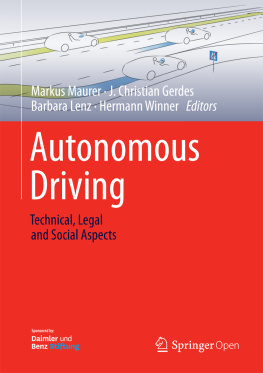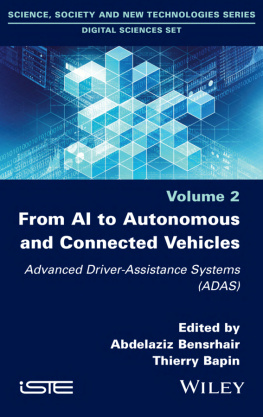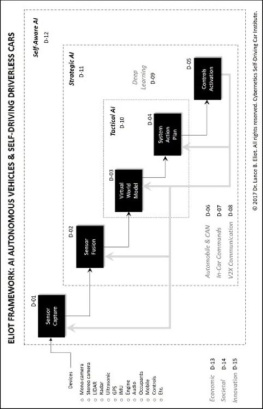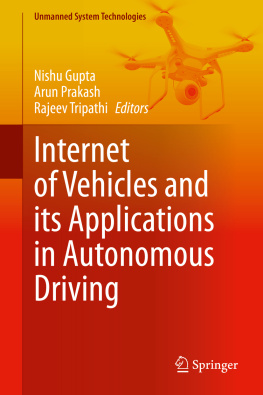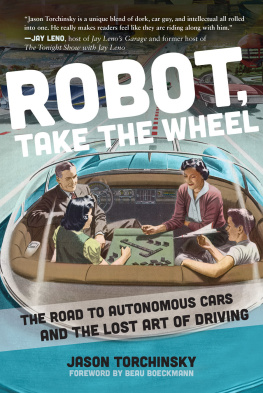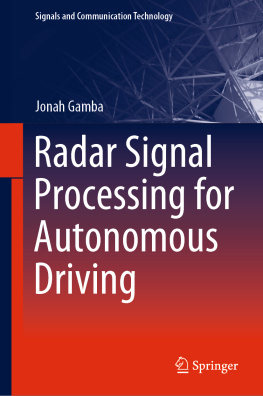Autonomous driving is a popular subject of discussion in todays media and, occasionally, a highly emotional one. Proclamations of success from car makers, system partners, and companies whose business models stem from other fields continue to fuel the debate. As late as 2011, as the Autonomous DrivingVilla Ladenburg project (which enabled the present volume to be published) was still being defined, we could not foresee how central the topic would be in public discourse at the projects end three years later.
In line with the objectives of the Daimler and Benz Foundation, the project aims to stimulate discussion on a technical topic of great social significance. It would be immodest and objectively false to credit growing discussion to this project when, at the same time, several leading global firms are using their research and public relations teams to position themselves in this forward-looking technological field. Nonetheless, the project influenced the public discourse decisively at various points, even if the connection was not immediately recognizable.
Indisputably, the Daimler and Benz Foundation has shown excellent and timely instincts in launching this project. Precisely because autonomous driving is currently receiving so much attention, the present volumes publishers deem it a good time to present as complete an overview of the topic as possible. For this discussion, researchers from various disciplines have taken up the task of sharing their viewpoints on autonomous driving with the interested public. This has brought many relevant issues into the debate.
As researchers, this has taken us into unfamiliar territory. We are addressing a specialist audience, potential stakeholders and the interested public in equal measure. Of course, this book cannot satisfy every desire. For further reading, then, please consult the prior articles of the project team in the journals and conference proceedings of their respective specialist fields. The Foundation also plans publications to accompany this volume that will summarize this books key findings and put them in everyday language.
1.1 What Is Autonomous Driving?
Even a quick glance at the current public debate on autonomous driving shows that there is no universal consensus on terminology. In order to bring about a certain convergence in how the terms of autonomous driving are understood among those involved in the project, some definitions were selected in a highly subjective fashion at the beginning of this project. These definitions were illustrated with use cases described in-depth (see Chap. ). These definitions are described in all of their subjectivity here.
For decades, word plays on the word automobile have been rife among pioneers in the field of autonomous driving []. Through training and dressage, carriage horses had learned for themselves (self = Greek autos , see above) to stay within the bounds of simple laws (Greek nmos : human order, laws made by people). In this sense, horse and carriage had thus both achieved a certain autonomy.
In the transition from horse carriages to automobiles, important obstacle-avoidance skills were lost, as undoubtedly was the occasional ability to undertake autonomous missions. Many a time would horses have brought a carriage home safely even if the driver was no longer completely fit for the journey. They would have at least have conveyed the vehicle in a safe state, eating their fill of grass on the wayside. The autonomous automobile aims to recover its lost autonomy and indeed go far beyond its historic form.
A special perception of Kants concept of autonomy, as formulated by Feil, came to be of importance in understanding autonomous driving within the project: autonomy as self-determination within a superordinate (moral) law []. In the case of autonomous vehicles, man lays down the moral law by programming the vehicles behavior. The vehicle must continually make decisions about how to behave in traffic in a manner consistent with the rules and constraints with which it was programmed.
It has to be said that the reaction of experts from diverse disciplines ranged and ranges from complete rejection of this definition to carefully considered approval. Independent of this, however, it is possible, by reference to the concept of autonomy interpreted and understood in these Kantian terms, to point out the direct linkage between technological development and ethical considerations.
The importance of this definition for engineers comes through clearly in my discussions with students. Confronted with this definition, engineering students in Braunschweig and Munich have in the last ten years come to understand that the development of autonomous driving requires them to not only research and develop technology but also to implement moral laws with utmost consistency. How does an autonomous vehicle behave in a dilemma situation, when at least one road user will inevitably be injured in an accident? This discussion is explored in greater depth in this book by Patrick Lin and Chris Gerdes (see Chaps. ).
To bring engineers and lawyers into agreement, various degrees of assistance and automation were defined in a working group drawn from the German Federal Highway Research Institute (BASt) []. The highest defined degree of automation was named Full Automation: The fully automated vehicle drives by itself without human supervision. Should system performance degrade, the vehicle is autonomously restored to the system state of minimal risk. From a technical point of view, the greatest challenge lies in the complete absence of a human supervisor who knows the system limits, recognizes system faults and, where needed, switches the vehicle into a safe state. Fully automated vehicles must monitor their own state autonomously, spot potential system faults and performance degradations, and thenwith a threatened drop in performanceinitialize and execute the transition to a safe state. Clearly, the safe state takes on a central role in the definition. What does a safe state consist of, however, when a fully automated vehicle is moving on the highway at 65 miles per hour (or even faster in Germany)?
Ohl [] pointedly concluded that the prototypes for autonomous vehicles demonstrated on public roads by research institutes, vehicle manufacturers, and IT companies in recent decades have only been partially automated in terms of the BASt definition. Safety drivers have supervised the automated vehicles; a production-ready safety concept for fully automated vehicles has yet to materialize. While there have been successful trips in which the safety driver has not had to intervene, to this day we lack evidence of the feasibility of journeys on public roads with fully automated vehicles.
Despite the concerns of some experts mentioned above, autonomous vehicles in the present volume are characterized by their self-determination within a superordinate (moral) law laid down by humans (Kant, as found in [].
For reasons of space, it has been decided for this book to forego a narrative history and a documentation of the state of research and the technology. Regarding autonomous road vehicles, Matthaei et al. [, Fabian Krger gives an arresting historical overview of autonomous driving as a visionary concept, or as science fiction, chiefly within image-based media.

